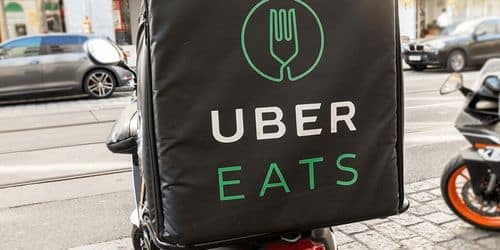For entrepreneurs like us, the meal delivery industry is now a tried, tested, and profitable business idea of the decade. Uber manages one such business under the sub-brand Uber Eats. With on-demand cabs, Uber has already made our lives easier. Its foray into the online food delivery sector was an attempt to do the same with yet another hyperlocal business model.
So, how exactly does Uber Eats work? How does Uber Eats make money from its food delivery service? Is Uber’s food delivery business strategy similar to its on-demand cab services? Who are Uber’s partners, and how does it find them? We will learn everything there is to know about Uber Eats as a hyperlocal on-demand business. Let’s start with the fundamentals.
What is Uber Eats?
Uber Eats, a subsidiary of Uber, is a food delivery service created in 2014 to extend the company’s ride-sharing business.
Uber Eats is the second-largest food delivery service in the United States, with over 21 million active users and a 26 percent market share.
DoorDash, Postmates, Grubhub, GoPuff, Instacart, Getir, and other food delivery services are among Uber Eats’ competitors.
How Does Uber Eats Work?
Uber Eats is essentially a flawlessly formed food triangle between-
- Partners in delivery
- Restaurant associates
- Customers
Restaurants advertise their brand and menu on the platform; clients in that region can find them and order from their menu using their phone or computer, and then one of Uber Eats partner drivers will pick it up from the restaurant and drop it off at the customer’s door.
Here’s how Uber Eats puts this three-tiered affiliation into action:
#1. Final Customers
Customers can purchase food from a wide range of eateries around them and can do it in two ways:
Customers who want to receive their cuisine shortly after ordering can pick the ASAP option while placing their order. They receive their dinner within 30 minutes.
Customers can schedule an order for the future using Scheduled Ordering. They can tailor their orders in terms of the delivery date, time, and address.
#2. Delivery Partners
Uber Eats delivery partners (also known as Uber Eats Drivers) are self-employed individuals that pick up food from restaurant associates and deliver it to clients. They are assigned delivery duties based on their location and proximity to the restaurant and the customer.
Uber Eats drivers are paid one pick-up fee for each new restaurant they visit, one drop-off fee for each distinct order they deliver, and a fixed amount for every kilometer/mile they travel to deliver. The approximate minimum payment before Uber’s service fee for each delivery is $4.
The company deducts a service fee of 15-30% from each driver’s final payment, depending on the area of operation.
#3. Restaurant Associates
Restaurants that collaborate with Uber Eats have a virtual presence on the platform. The restaurant partners pay Uber Eats a 30% commission on the cost of each item delivered. The restaurants set the pricing for each item on the Uber Eats menu (OFTEN differs from the rates at the physical restaurant).
In exchange, the restaurants enjoy the publicity, technical advancements, and continuous communication with their customers.
The Business Model of Uber Eats
Uber Eats operates on a four-step methodology, which involves the following steps:
- The customer search for the best restaurants
- The customer placing the order
- Uber Eats drivers pick up the order from the restaurant.
- Order fulfillment and payment receipt
Uber Eats blends the Aggregator and Hyper-Local On Demand business models.
It has three major transactional segments. These are the three ways Uber Eats makes/invests money. It employs a three-tiered transactional strategy:
- Business to Business (B2B),
- Business to Partner (B2P), and
- Business to Customer (B2C)
Restaurant partners with Uber Eats fall under the strategy’s business-to-business (B2B) component. They have already established businesses that profit from another business (in this case, Uber Eats) in exchange for money.
Uber Eats drivers are not employees but instead brand partners. They fall under the strategy’s business to partners component. They are the independent partners who profit from and earn revenue from the firm.
The third factor is the customers, who receive meals in exchange for money and are frequently entitled to enticing discounts and incentives.
How Does Uber Eats Make Money?
How does Uber Eats make money with over 21 million monthly active customers and 500,000 eateries on their network in 1,000 US cities?
Here are the five ways Uber Eats makes money in 2023:
#1. Eats Pass (Monthly Subscription)
Eats Pass is Uber’s own monthly subscription option for customers.
It has several tiers. Customers can get limitless free delivery and a 5% discount on orders above $15. For $24.99 per month, they can receive that plus 10% – 15% off Uber rides.
Subscriptions are $9.99 per month for Uber Eats and $24.99 per month for Uber plus Uber Eats.
#2. Advertised Listings
Uber will launch a new product called Sponsored Listings in August 2020. Allowing collaborating eateries to promote their establishment through in-app advertising.
The merchant initially
- establishes a weekly marketing budget and then
- chooses whether they want to manually or automatically regulate how much to bid per click.
Uber Eats sponsored listings to operate on a pay-per-click (CPC) basis. The merchant is only charged when a customer clicks on their ad.
Advertising costs: According to Uber, the average ad spend per participating restaurant is $50 per week.
#3. Uber Eats for Business (commission)
Uber Eats has over 500,000 eateries on its platform and expects to handle more than $25 billion in food delivery.
Every time a transaction is completed on their marketplace, Uber Eats receives a commission, a percentage of the order subtotal.
Commission:
- Fee for activation: $350 one-time setup fee
- Fee for the marketplace: 15% – 30% commission
The commission rates differ based on whether the partnered merchant utilizes their own delivery team or the Uber Eats marketplace platform.
#4. Fees (delivery fees, service fees, minor order fees, and delivery adjustment fees)
Uber Eats charges delivery costs, service fees, small order fees, and delivery adjustment fees on each qualified order.
Uber Eats began with a flat $4.99 delivery cost before switching to a sliding scale in 2018. The delivery rate will vary depending on location and time of day.
Service Charges
- Every order includes a service fee, whether you have an Eats Pass or not.
- 15% of the subtotal (minimum of $2)
Fees for Small Orders
A modest order fee is another fee that Uber Eats charges. This discount will be applied at checkout if your sum is less than $10 or $15.
$2 (for subtotals under $10) $3 (for subtotals under $15)
Fees for Delivery Adjustment
A delivery adjustment fee is added to the order only if it is amended after the completed transaction.
#5. Uber Gift Cards
Uber Eats sells gift cards that may be redeemed using the Uber Eats or Uber app.
Pricing:
Solo gift cards are available in denominations of $25, $50, $100, and $200.
Gift cards in bulk for businesses: A minimum of $500 or 25 cards is required.
Customers can spend their gift cards across the Uber network. Both for meals and ride-sharing.
American Express and Uber Eats Collaboration
In 2019, American Express and Uber announced a collaboration to launch an Uber Reward Program for select American Express members.
They expanded that collaboration to include Uber Eats in October 2020, bringing even more benefits to American Express card customers.
Members of the American Express Gold Card receive $120 in Uber Cash each year ($10 per month) may be used on Uber Eats orders or Uber rides in the United States.
Uber Eats Accepted Payment Methods
All payments and transactions are done through the Uber Technologies account because Uber Technologies is the parent firm. They are in charge of collecting all payments from the parent company’s departments listed below;
Restaurant Partnership
- Uber Eats
- Uber Freight:
- Advanced Technologies Group
- Uber For Business
- Uber Elevate
Payment Method
- Option 1: Use a credit or debit card
- Option 2 is PayPal
- Option 3 is Venmo.
- Option 4: Link Your Bank Account Option 5: Use Uber Cash
What is the Revenue Model of Uber Eats?
Uber Eats makes money by combining several revenue streams within their organization, which are as follows:
- Software as a service (SaaS)
- Business concept dependent on commissions
- FFS (fee-for-service) business model
- A business model focused on advertising
- Business model B2B2C (partnerships)
- Marketplace Business model
Profit and Revenue Figures for Uber Eats
Uber Eats earned 2.51 billion USD of its parent company’s $14.15 billion USD sales in 2019.
Because Uber, the parent business of Uber Eats, is a publicly-traded company, they are required by the Securities Exchange Act of 1934 to post continuous financial statements with the SEC. Uber’s publicly available financial records may be found in its reports and presentations.
The Finance and Valuation of Uber Eats
According to Uber’s crunchbase profile, Uber, the parent company of Uber Eats, has received a total of $25.2 billion in 28 rounds.
The Future of Uber Eats’
In the United States, almost no delivery business is expanding as quickly as Uber Eats. It has seen a significant increase in recent years and anticipates an even brighter future.
Eats is a briskly expanding industry. It is now generating $6 billion in bookings yearly, an increase of more than 200 percent. – CEO Dara Khosrowshahi speaking at the Code Conference in Rancho Palos Verdes, California.
Uber Eats has already been shown to be a scale-up company. The Uber Eats restaurant food delivery service has gone from an experiment to supplying the majority of the United States and significant cities worldwide in three years.
Uber Eats has a promising future if it maintains or raises its current standards. The main thing to remember is to keep the clients, as well as the delivery and food partners, happy.
Conclusion:
Now that you understand entirely Uber Eats’ statistics, business plan, and income production methods, let’s look at how you can create a food delivery service that can compete with Uber Eats.
Creating an on-demand food app like Uber Eats is a time-consuming and expensive procedure. It will also take a few months to develop the app. You can buy an UberEats clone with nearly all of the functionality the aggregator app should have. The app will cost one-fifth to one-sixth of what it would cost you to develop. The most exciting aspect is that you can deploy the app in a few days, and your business can go live immediately.
The app supplier will also be able to make the necessary changes to the app to meet your company’s strategies. The cost of customization will also be relatively minimal. You can customize the software in stages as your company earns money from it.
Related Articles
- UBER REQUIREMENTS: Uber Drivers Requirements
- HOW DOES UBER MAKE MONEY? All You Need To Know
- UBER LOGO: The Success Story of The Uber
- UBER WORTH: Is Driving for Uber Worth It?






